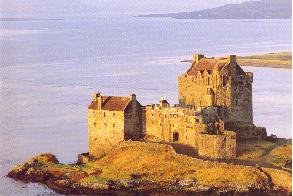
Places to Visit in Scotland
- Eilean Donan Castle

History
When Marigold MacRae looks down from her private apartments in Eilean Donan Castle, she sees the confluence of three of Scotland's most beautiful sea lochs, Loch Long, Loch Duich and Loch Alsh. In 1719, the same view would have revealed three English men o'war, the frigates Worcester, Enterprise and Flamborough, each with their great guns trained upon the grey stone ramparts of the castle. The MacRaes, who had come out in the first Jacobite Rising in 1715 were using the castle to billet infantrymen sent from Catholic Spain to assist the cause of the Old Pretender. True to their clan motto, Fortitudine, (strength) the MacRaes spurned the English demand for surrender. The frigates' relentless barrage continued until Eilean Donan, which had stood since the early 14th century, was reduced to little more than a smoking ruin. The MacRaes were forced into the hills and the Spanish were taken prisoner. Eilean Donan remained a pile of rubble for more than 200 years until lieutenant Colonel John MacRae Gilstrap, grandfather of Mrs MacRae's late husband, undertook its restoration at enormous personal cost. Today, Eilean Donan is owned by the Conchra Charitable Trust. Marigold MacRae, President of the Clan MacRae Society in Scotland, is one of the Trustees who retains custody of the castle in the public interest. Bruce Stannard was honoured to be her guest.Restoration of Eilean Donan
Mrs MacRae says she is sure that when Lieutenant Colonel John MacRae Gilstrap purchased Eilean Donan in 1912, he never intended to do anything other than keep the castle as a ruin. "But", she says, "thanks largely to this wonderful man, Farquar MacRae, he decided to go ahead and restore it. Farquar MacRae was a highly skilled stone mason and he was employed initially only to clean up the site. But when my husband's grandfather came home from the First World War he found that Farquar had gone much further than simply cleaning up a bit. He was all set to re-build. He claimed to have had a dream in which he said he saw, in the most vivid detail, exactly the way the castle originally looked. Fortunately, Colonel MacRae Gilstrap married a very rich lady, Ella Gilstrap, and luckily, she was as enthusiastic as he was. So, with her money and their combined enthusiasm they rebuilt the castle over 12 years between 1920 and 1932."
"The extraordinary thing is that after the restoration was completed, the plans for the castle were discovered in the archives of Edinburgh Castle and lo-and-behold, they were exactly as Farquar had dreamed them to be. That is why Eilean Donan is known as The Castle of Dreams. It really has given an immense amount of pleasure to a great many people. Of course, there were one or two people, back in the 1920s, who grumbled to the newspapers complaining that the MacRaes were spoiling this picturesque old ruin with all their restoration. But all that's forgotten now and I think most people love what's been done."

"Throughout the world, Eilean Donan is the one place people generally call to mind when they think of Scotland. In that superbly romantic setting, surrounded by all those wonderful tree-clad hills, it really does seem to have a rare dream-like quality. And that's what people remember. It is the quintessential Scottish castle. There's no doubt about that. I love it. It's so stark and yet so utterly beautiful. It has none of those funny little pepper-pot turrets that adorn so many Scottish castles. Eilean Donan is a fortress. It stands there brooding and defiant. And I suppose in that sense it is a bit of a metaphor for the Highlanders themselves. The whole of the Highlands and certainly its people, have been knocked about rather cruelly over the years. But they’ve got up again, rebuilt their lives, in some cases far away. Yes, they are a tough and resilient people. They've had to be. Which is why they were so wonderfully equipped for all the trials of frontier life when they emigrated to Australia and New Zealand, Canada and America in the 19th century."
The above article and illustrations are reproduced by kind permission of the "SCOTS" Heritage Magazine. The printed magazine has full-size glossy photographs which the Internet cannot match. You can subscribe to the SCOTS Heritage Magazine via their Web Site.
Return to Index of Places to Visit
Where else would you like to go in Scotland?

